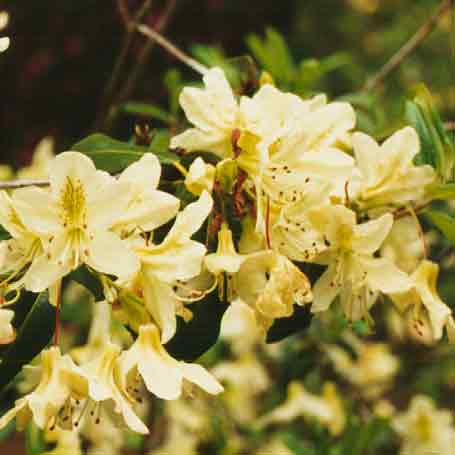
The majority of the 30 or so rhododendrons introduced by Joseph Hooker from his 1848-1850 expedition to Sikkim have become well known and, at least in species collections, widely grown. Showy and impressive species such as thomsonii, arboreum, niveum, maddenii, edgeworthii, falconeri, hodgsonii, griffithianum, campanulatum, barbatum, and cinnabarinum gained the widespread attention and admiration of western gardeners and botanists following this historic expedition into the eastern Himalayas. To this day, these plants make up the “backbone” of a species collection in most gardens and many are commonly used in hybridizing programs.
Not all of Hooker’s introductions have gained this lasting popularity, however. For various reasons, whether the lack of a sufficient floral display, hardiness issues, or difficulty in cultivation, several of his introductions, including R. triflorum, remain relatively uncommon in gardens. The lack of interest in R. triflorum is probably related to the fact that it is quite variable over its extensive range, and many of the more desirable forms, including those considered to have superior flowers, such as var. bauhiniiflorum, are typically less hardy. Overall, the species is quite ornamental, with its beautiful glossy smooth and exfoliating pale-to-deep chocolate brown bark, aromatic shiny foliage, and late season, more-or-less yellow small flowers.
Following its introduction by Hooker in 1850, this variable and often common species was widely collected by later plant hunters from throughout its extensive range. R. triflorum occurs at elevations ranging from 7,000 to 13,000 feet (2,100 to 4,000m) in the eastern Himalaya from E Nepal through Sikkim and Bhutan, including adjacent areas of N India (West Bengal) and eastward into the mountains of SE Tibet and the N Myanmar/Tibet/Indian frontier. It was also collected by Frank Kingdon Ward in 1928 from an isolated population in NE India (Manipur & Nagaland) where it occurs from 8,000 to 9,500 feet (2,400 to 2,900m). Although quite similar to R. triflorum, this new collection was named R. bauhiniiflorum due to its distinct range and larger, flatter flowers. This species was reduced to varietal status within R. triflorum in 1980 by Dr. Cullen. Forms from the eastern end of the range (SE Tibet and adjacent Arunachal Pradesh) were originally described as var. mahogani (now lumped into var. triflorum and best referred to as R. triflorum var. triflorum Mahogani Group). These have non-peeling bark and often have a reddish coloring in the flowers, whether a suffusion, blotch and/or spots. These are now understood to be nothing more than color variations within populations. The flower color in Mahogani Group is quite variable and the plants tend to be hardier. Chinese botanists have recently located an amazingly disjunct population of this species which they have named R. triflorum ssp. multiflorum, distinguishing it on the basis of its very isolated range and in having four to five flowers per inflorescence (versus the typical two or three). They collected this subspecies in the Wuliang Shan of SW Yunnan Province, China.
R. triflorum is a lepidote or scale-bearing rhododendron and is the type species for Subsection Triflora. It is found in a wide variety of habitats, although like most rhododendrons, it is generally restricted to mountainous situations with cool, humid air and plenty of precipitation. I have been fortunate in having the opportunity to observe this interesting species on both ends of its wide range, noting firsthand the variation and distinguishing characteristics. I first saw this species in the wild in the spring of 1997 while on an expedition to Sikkim where I observed the plant as it was originally described by Hooker back in 1849. The populations of R. triflorum in this area are very typical of the eastern Himalayan type (var. triflorum), with glossy, dark brown peeling bark and shiny leaves which are bright glaucous-white beneath. It was too early in the season to enjoy any flowers, but I was more than impressed with the overall character and beauty of the plants. I noted plants of this species in habitats ranging from shaded moss-covered cliffs, growing with numerous other Ericaceae to dry, treeless, grassy slopes where it grew with R. ciliatum. Plants grown from seed collected on this trip have been flowering in the nursery for several years now. The flowers are rather small and a bit pale in color, but this “lack” of floral display is made up for by the glossy foliage and stunning, smooth and peeling, deep chestnut brown bark.
In 2003 I observed the rare, disjunct and rather localized R. triflorum var. bauhiniiflorum in its native habitat while exploring the mountains of Nagaland in the northeastern corner of India. On these isolated peaks this species grew on steep rocky forested slopes with a very interesting selection of species including macabeanum, johnstoneanum, and elliottii. All three, like var. bauhiniiflorum, are endemic to the Naga Hills.
As in almost every other characteristic, this species varies greatly in size, ranging from fairly small and seemingly delicate to a large and vigorous thicket-forming shrub up to 20 feet in height. As I have mentioned previously, the bark is much shinier, smoother, and more peeling in the typical western (Himalayan) form than that of the eastern populations. The leaves are typically aromatic, somewhat elliptic in shape and up to three inches (c. seven cm) in length. As with the bark, there are obvious differences in foliage characteristics between the western (very glaucous on the underside) and the eastern populations (green or only slightly glaucous beneath); the lower surface is always dotted with tiny brown scales spaced approximately their own diameter apart. The flowers (late spring to early summer) are borne in a terminal inflorescence of two, three, and sometimes four, thus the epithet “triflorum” meaning “three-flowered.” The individual flowers are widely funnel-shaped and up to one and a half inches (four cm) across except in the NE India population (var. bauhiniiflorum) where they are much flatter in shape and one and a half to two inches (four to five cm) across. They range in color from pale yellow to bright yellow or greenish, usually with greenish spots and, in the case of the SE Tibetan/Arunachal Pradesh populations (Mahogani Group), variously marked or blushed with red or reddish-brown. The calyx is quite small, the ovary is covered with scales, and the style is typically smooth.
In cultivation, R. triflorum, like most members of Subsection Triflora, is vigorous and easy under normal rhododendron growing conditions. It prefers strong light but performs more than adequately in partly shaded conditions. As always, good drainage is essential. The hardiness varies somewhat as would be expected from a species with such a wide distribution. Most forms of this species should be hardy from +10°F. to 0°F. with the typical Himalayan as well as the NE Indian (var. bauhiniiflorum) forms generally less hardy than those from SE Tibet.
I am unaware of any awards this species may have received, and the only hybrid I could locate was a cross with R. xanthostephanum called ‘Butterball.’
ACCESSIONS IN THE COLLECTION OF THE RSF:
var. triflorum
1970/026 (Mahogani Group) Robbins. Flowers tinged red with gold-green spots.
1977/156 Berg. Creamy yellow flowers with gold-green flecks.
1977/423 Larson. Flowers yellow with gold-green spots.
1980/097 KW#6409:RBGE.
var. bauhiniiflorum
1973/026 Robbins:Brydon.
NOTE: We have numerous newer accessions of both taxa grown from seed collected in the wild. These are still under evaluation.
REFERENCES:
Cox, Peter A., and Kenneth N. E. Cox. 1997. The Encyclopedia of Rhododendron Species. Perth, Scotland. Glendoick Press.
Cullen, J. 1980. A Revision of Rhododendron. I. Subgenus Rhododendron sections Rhododendron & Pogonanthum. Notes from the Royal Botanic Garden Edinburgh. Vol. 39(1): pgs.
Davidian, H. H. 1982. The Rhododendron Species. Vol. I. Portland, OR: Timber Press.
Feng Guomei. 1992. Rhododendrons of China Vol. II. Beijing and New York: Science Press.
Hootman, S.E. Unpublished field notes 1995-2007
Rhododendron Species Foundation: Records – 1964 to present.
Steve Hootman
